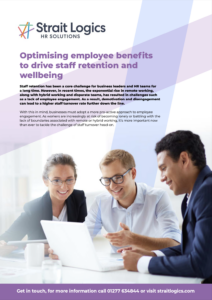
With many industries still struggling to fill talent gaps, and businesses struggling with talent shortages, the pressure is on when it comes to attracting and retaining staff.
In times like these, employers must find a way to clearly showcase their value to their employees – highlighting flexibility, culture, and monetary and financial advantages. Illustrating how every employee plays a part in the future of your business has never been more important. Likewise, finding a way to clearly communicate this to potential new talent, could be a game changer for businesses looking to onboard the best staff for the year ahead and beyond.
One of the most valuable tools for businesses to have on hand is a Total Rewards Statement (TRS). This blog explores what this is, and how best to implement it for your business.
What is a Total Rewards Statement?
You may have seen the term bandied around on HR sites and newsletters. You may also have seen the acronym TRS, and wondered what it stands for. A Total Rewards Statement is simply a customised document that showcases a holistic representation of the value for each individual employee, quantifying the worth of the employee-employer partnership.
Typically owned by the compensation and benefits team within HR, those who don’t have such a team can still implement and offer it with some careful employee retention planning, strategy and collaboration with relevant stakeholders. In fact, your Total Rewards Statement should form a crucial component in communicating your wider Total Rewards Strategy. That means including everything you offer your employees by way of investment – such as pensions, shares, pay, flexibility, and learning and development. A well-executed Total Rewards Statement could be one of the most efficient ways to convey the comprehensive employee value proposition and nurture acceptance and engagement among your employees.
Aiming for thoroughness, an advanced TRS should also include access to any personalised employee services offered, such as wellness programs, occupational therapy and learning and development prospects. On a practical level, Total Rewards Statements serve as effective tools during negotiations with new talent and internally as a means for employees to comprehend the organisation’s value offerings, thereby enhancing employee engagement and retention.
Why are Total Rewards Statements important?
One common theme of staff engagement is that employees often lack an understanding of their benefits. Despite HR endeavours, studies indicate that 42% of employees don’t know about or understand their staff benefits. Likewise over 1 in 4 employees struggle to understand their payslips.
With employees in the dark about what they’re benefitting from, and what they’re entitled to, it’s time to get transparent about Total Rewards.
The battle for talent continues, particularly in critical skill areas, we’re seeing a more competitive pursuit between employers striving to position themselves as the employer of choice. That means, building a unique proposition to attract the right employees. Review sites such as Glassdoor have made businesses that don’t focus on this value proposition much more vulnerable in a new landscape of online sharing and openness.
Many businesses have implemented Total Rewards Statements in recent years as this humble document could become an integral aspect of employer branding in the race to secure and engage new talent.
What should your Total Rewards Statement include?
Businesses should consider their Total Rewards Statements like a catalogue that highlights everything it provides in the way of value to their potential candidate and current employees. There are four key aspects of the employee value proposition that should be included within the TRS:
- Financial rewards: Involving elements that directly translate into monetary value, like salaries.
- Monetary benefits: Quantifiable components paid on behalf of the employee to external providers, such as medical insurance.
- Non-financial rewards/investments: Comprising quantifiable benefits not in cash, such as learning budgets.
- Intangible rewards: Encompassing value propositions challenging to quantify, like flexibility or access to specific equipment.
Not all organisations think to include each of these categories in their Total Rewards offerings, but it’s important to include everything that could be classed as a valued asset by your employees. Evaluating the end-to-end employee value proposition, encompassing services from partners like facilities or corporate social responsibility, allows a comprehensive assessment of all elements reflected in the Total Rewards Statement.
How should they be used in the workplace?
Your Total Rewards Statements should become an integral tool as part of an effective employee communication strategy. Effective reward communication is pivotal for fostering employee awareness and recognition of their complete benefits. These statements are often used by businesses for the following reasons:
- Enhancing an employer’s capacity to attract, recruit, and retain top talent. Clearer total rewards communication tends to be the standout choice for long-term benefits. By visually portraying an organisation’s comprehensive total rewards strategy and flexible benefits scheme during recruitment, onboarding, or performance reviews, employers establish a more robust employer brand.
- Mitigating salary inflation and reducing employee expenditure. Frequently employed in performance, development, and salary reviews, total rewards communication effectively enhances an employee’s current compensation package. As salary costs escalate, it’s crucial for modern employers to find cost-effective means of accurately conveying existing total rewards, benefits, and compensation packages to their workforce.
Could you be making better use of your Total Rewards?
As businesses continue to compete for the top talent, it could be time to put your Employee Value Proposition under scrutiny.
Or it might just be time to maximise what you already have with clearer, more accessible documentation, and transparency so that your employees aren’t left in the dark about the what’s available to them.
Our comprehensive employee benefits software ensures that every one of your employees knows their true value from day one. With Strait Logics HR solutions, you’ll be able to fine-tune your TRS, and give your staff easier access, and clearer information.
Want to see if we could help to transform your employee retention system? Get in touch today

